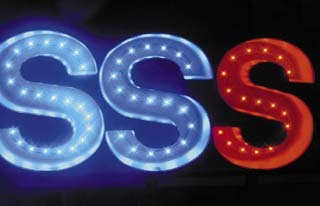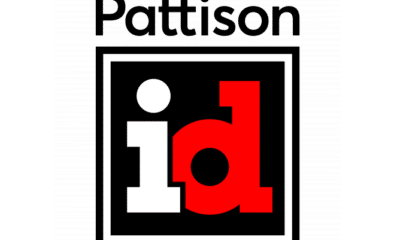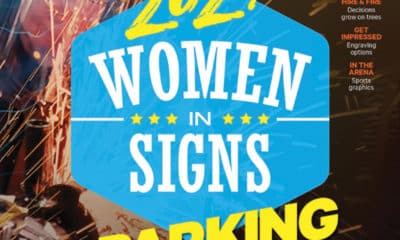LEDs + Lighting
LEDs: Truth or Dare?
An overview of the LED market sheds light on the technology’s sign applications.
Published
18 years agoon

Lately, have you attended any industry tradeshow, association meeting or educational event without seeing LEDs feted? Have you read a sign-market publication without noticing editorial features, press releases and full-page advertisements on the topic? LEDs are everywhere, it seems.
Does all the hoopla have you wondering how others are faring with their use of LEDs? Do you wonder what sign programs specify LEDs? What experiences, both good and bad, have individual sign companies had? With all the fuss, what’s actually going on in the field with LEDs? This article is a fresh review of the latest news across North America.
Sign-market LED application remains relatively new. LEDs for channel-letter use first appeared nearly three years ago. Subsequently, their initial major market launch occurred during the International Sign Assn’s Sign Expo in May 2000. Generally, LEDs have been used for channel letters and outline-lighting applications for approximately 18 months.
During that time, LEDs have enjoyed extraordinary market growth. Mainstream use of outdoor-sign LEDs has grown from zero sales to more than $15 million annual sales today. A half-dozen major market players and more than 20 companies market an LED product for channel-letter and/or outline-lighting applications. The market is obviously growing.
(Note: My sales estimate is based on lengthy discussions with contacts at all distribution levels. It’s also subject to assumptions of continued use by select national sign programs.)
Under surveillance
AdvertisementSurveys involving various industry contacts reveal surprising feedback. Despite trade-press fanfare (including this publication), LED usage hasn’t achieved "mainstream" nor "prime-time" status. Most sales are driven by major purchases of national sign programs, via production-scale sign companies operating on a regional or national level.
So far, widespread use of LEDs eludes the thousands of North American electric-sign companies. Market substitution of LEDs for neon tubes appears to be less than 10%, and perhaps only 5%.
However, LED interest remains high, and experimentation proliferates. LEDs truly are everywhere, albeit in less volume than marketers suggest. LED promotion is both prevalent and persuasive — legitimately so, because LEDs appear to be the next great lighting technology.
Davey Glantz, N. Glantz & Son (Anaheim, CA), shared this perspective: "We see LED use growing very quickly. And surprisingly, this isn’t limited to California. We’ve had strong sales in other branches, particularly the Midwest and New York metro. Most of our branches have anywhere from several key accounts to several dozen regular purchasers. [Sales are] typically initiated by large projects, though."N. Glantz & Son
Glantz offered key points regarding the attraction: "Why LEDs? Well, the driving force right now for LED use is from the end-user side. National chains who buy large quantities of signs note prospects for energy savings and take it from there. What we’re hearing from some sign companies is that they expect LED use to be simpler than using neon."
Glantz added that, generally, his customers were satisfied with their LED experiences. They understand that most LED sign installations will be more expensive than neon applications. The tradeoff is expected to be long-term performance, maintenance savings and energy efficiency. According to Glantz, negative surprises with early use of LEDs are related to light output. Oftentimes, either the sign company or user isn’t pleased with the brightness or color appearance of LEDs, compared to neon.
AdvertisementGerry Hanssen of Talley Anchor Signs (Chesapeake, VA) has a slightly different perspective. "I have many customers asking for LEDs," He said. "Because of all the advertising and trade press, they’re aware of it.
"However, this industry can be frustrating. The sign industry is always trying out new technologies before they’ve been totally field-proven. So, we tend to get surprises, inconsistent results and unhappy customers. We work with it, but it’s not always that simple."
Problems often occur when any new technology is introduced to the sign industry. LEDs are no different.
A visible early adopter of LEDs, British Petroleum, launched a bold new re-imaging program several years ago that incorporated energy-saving technology. Thus, initiatives for solar panels and LED lighting were implemented. Since its inception, the BP re-imaging program has had difficulties using LEDs for green outline lighting.
Unexpectedly, BP experienced premature failure of LED modules. Subsequent evaluation showed damage from the egress of water and/or presence of damaging temperature conditions. This doesn’t denigrate LED modules’ integrity, only their application.
This is a significant distinction. As with many sign-application materials, the details must be correct. A sign isn’t merely a collection of materials and components. It must be designed to work harmoniously. At the time, LED providers for the BP project lacked a "critical mass" of sign-application experience to assure client satisfaction.
AdvertisementProgress has occurred since the BP launch two years ago. Numerous system providers have offered improvements for the green-outline lighting program. The more broad-based market has progressed, particularly by using red LEDs in channel letters.
Hanssen takes a similar, more methodical, approach. "We have almost three years’ field experience now with LEDs," he explained. "We saw potential in the new technology and began to cautiously use LEDs in local jobs. Now, we’ve installed as many as 15 jobs. It’s great technology. However, I thought they’d progress faster. There have been some mistakes made through misunderstanding of what signs are all about."
Market realities
Today, red LEDs are widely accepted. Most of Hanssen’s installations have been red, and he’s satisfied. He hasn’t seen one significant failure using reds.
Also, Taylor is, as one would imagine, very comfortable using red LEDs, regarding both performance and cost effectiveness. His geographic experience spans myriad applications from the Southeast through Eastern Canada.
LEDs have also been increasingly used in outline- or contour-lighting applications. Hanssen said, "Of course, LEDs possess some distinct advantages. New requirements for secondary ground-fault protection complicated the use of neon transformers. Especially for border-tubing applications, we’re finding LEDs easier to install, service and keep lit."
We remain in the early days of LED sign-lighting evolution. As Glantz observes, custom sign companies don’t routinely promote LED use nor position them as "the neon substitute." LEDs are offered as an alternative that gives customers more options.
"We see sign companies making their customers aware of LEDs, not necessarily pushing them, he noted. "Often, it can be simpler and more beneficial to keep jobs as is, conventionally illuminated with neon."
Interestingly, several sources believe the sign industry’s neon-related participants have stepped up to meet the LED challenge. Solid-state neon power supplies certainly have increased for channel-letter applications. These power-supply designs tend to blunt the touted LED advantages of energy savings and ease of use.
Hanssen said, "We’re finding our neon suppliers are becoming more attentive. Maybe it’s because industry activity is slow right now, but neon suppliers are keeping tube usage economically advantageous. Neon tubes are readily available, not just locally, but across the country. Plus, turnaround times are very quick on orders for wholesale tubes, and stock is more easily available than for LED products. We’re finding it sometimes frustrating to get the right inventory at the right time from distributors. Neon components are much more standardized than those used for LEDs, and you can always assume you can find neon parts."
Future direction
Clearly, America has changed its view of energy use. The West Coast is attracted to LEDs’ strong suit — their relative efficiency in power consumption. On paper, energy-efficiency calculations favor red LEDs over clear-red neon tubes. It’s just the opposite when blues, greens and whites are compared to the argon/mercury luminous tubes produced by the typical neon shop. With the available LED technology, such fluorescent-light sources as hot- or cold-cathode lamps are much less expensive to install and operate.
Glantz noted that California’s LED use is particularly driven by power companies and regulatory bodies whose long-term motivation is to save energy (see ST, August 2002, page 176 and December 2002, page 108). Taylor sees similar dynamics in parts of Canada.
Glantz also noted that many West Coast LED applications involve retrofitting existing channel letters with red LEDs, driven by incentives offered by local power providers. Glantz says that, if the decision is made to invest in LEDs, replacement is fairly simple. It’s the upfront cost that must be weighed.
Presently, LEDs are expensive. Further, extremely wide gaps distinguish the installed costs of red LEDs and whites, which are the newest, most expensive LEDs, as much as $30 per foot. Well over $100 worth of white LEDs is needed to duplicate the light output of a typical 8-ft., HO fluorescent lamp. Yet, white LEDs average only half the life expectancy.
But things change. LED technology is progressing rapidly — every six months, a new breakthrough seemingly occurs. LED lighting has such powerful potential that hundreds of millions of R&D dollars are being spent by global technology companies. Ultimately, they’re targeting LEDs for mainstream lighting as a substitute for conventional incandescent, halogen and fluorescent light sources.
For now, white LED use is reserved for unique reasons. Here’s Hanssen’s experience. "Our customers want them, especially for reverse halo-lit letters. We’ve got some big jobs in the works. But we can’t seem to keep them lit. And we’re not happy with the color consistency or how that changes over a relatively short time. It’s good news, bad news. The technology for white LEDs is so new."
Will LEDs penetrate more sign applications? The odds they will are extremely high. Will sign companies continue to experiment and gain experience? Yes. Glantz knows medium-sized signshops that are developing their own LED systems. The potential is very great.
Who can really predict the future? The safe bet is that sign people will adapt and innovate. They’ll find the best ways, sometimes through trial and error, to satisfy their customers’ needs for illuminated signs and identity lighting. LEDs will continue to grow in use. Neon and fluorescent tube use will continue, as well.
SPONSORED VIDEO
Introducing the Sign Industry Podcast
The Sign Industry Podcast is a platform for every sign person out there — from the old-timers who bent neon and hand-lettered boats to those venturing into new technologies — we want to get their stories out for everyone to hear. Come join us and listen to stories, learn tricks or techniques, and get insights of what’s to come. We are the world’s second oldest profession. The folks who started the world’s oldest profession needed a sign.
You may like
Advertisement
Subscribe

Magazine
Get the most important news
and business ideas from Signsofthetimes Magazine.
Advertisement
Most Popular
-

 Real Deal2 weeks ago
Real Deal2 weeks agoA Woman Sign Company Owner Confronts a Sexist Wholesaler
-

 Projects2 weeks ago
Projects2 weeks agoGraphics Turn an Eyesore Cooler Into a Showpiece Promo in Historic Plaza
-

 Projects3 days ago
Projects3 days ago4 of the Most Fun Sign Projects in Years
-

 News3 days ago
News3 days ago2024 Sign Contest Open for Submission
-

 How To18 hours ago
How To18 hours agoMaking the Grade with ADA Signs
-

 Business Management2 weeks ago
Business Management2 weeks ago3 Things Print Pros Must Do to Build Stronger Relationships in the Interiors Market
-

 News2 weeks ago
News2 weeks agoPattison ID New Name of Five Companies
-

 Manager's To Do1 week ago
Manager's To Do1 week agoMarketing Signs to Schools, Tradeshow and Quote Follow-up Make May’s List












